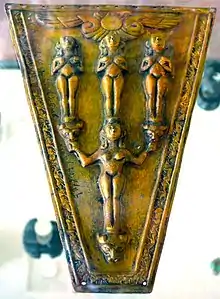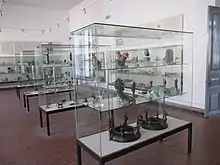Hazael horse frontlet
The Hazael horse frontlet is a bronze horse frontlet discovered at the Heraion of Samos, inscribed in Phoenician characters for Hazael (proposed by scholars to be the same as Hazael of Aram Damascus). It is considered to have been made in North Syria, perhaps at Arslan Tash.[1][2]

It is on display at the Archaeological Museum of Vathi at Samos (B2579).[3] The inscription is known as KAI 311.
Discovery and description

It was found in 1984 at the Heraion of Samos. It is 27.3 centimetres (10.7 in) long.[2]
On its left side, it has a single line of inscription, which can be read horizontally when the artefact is rotated by approximately 120 degrees. The text is 16 centimetres (6.3 in) long and consists of 36 characters that are between 3 and 9 millimetres (0.12 and 0.35 in) high.[2]
References
- EPH’AL, ISRAEL, and JOSEPH NAVEH. “Hazael’s Booty Inscriptions.” Israel Exploration Journal 39, no. 3/4 (1989): 192–200. http://www.jstor.org/stable/27926152.
- Röllig, W., 1988. ‘Die aramäische Inschrift für Haza’el und ihr Duplikat’. In H. Kyrieleis & W. Röllig (eds), Ein altorientalischer Pferdeschmuck aus dem Heraion von Samos, 62-75. (Mitteilungen des Deutschen Archäologischen Instituts, Athenische Abteilung 103.) Athens: Deutsch-archäologisches Institut
- Archaeological Museum of Vathi at Samos